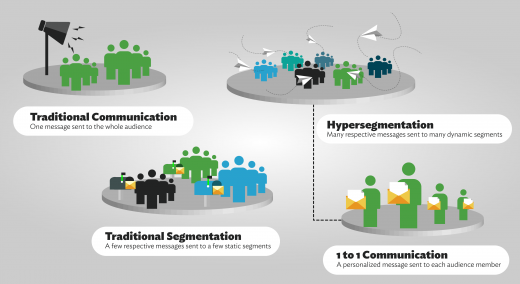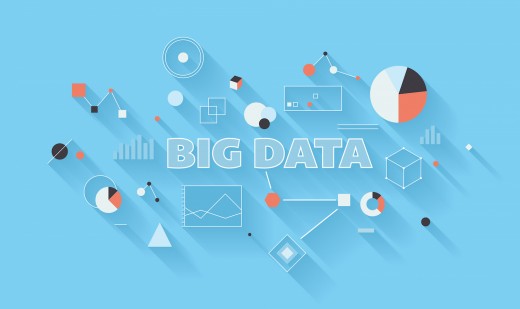
The Holy Grail of today’s data-driven marketing landscape was actually discovered far from any boardrooms or Silicon Valley tech centers. One must actually look to the laboratory; or more precisely, under the microscope. It’s because it’s not an X-factor that will save CMOs, but more closely an X-chromosome. The antidote that should be in every marketers medicine chest is hypersegmentation.
Taking a Look Under the Microscope
Dr. Carl Sagan stated, “you have to know the past to understand the present.” Therefore, before we can learn how to apply hypersegmentation to marketing we must first take the time to understand the term’s biological origins.
Long before it made its way to marketing circles, hypersegmentation was first introduced as a clinical term. The simplest definition of hypersegmentation is the excessive division of a tissue into segments known as lobes. More specifically, hypersegmentation occurs within neutrophils, which are the most abundant type of white blood cells found in mammals, forming an essential part of the innate immune system.
In healthy people, no more than three percent of neutrophils have more than five lobes. However, in genetic mutations six, seven or even eight lobes can be found. This hypersegmentation of the neutrophils is linked to iron and vitamin deficiencies, leading to forms of anemia.
How is Hypersegmentation Applied to Marketing?
While hypersegmentation in cells is the cause of sickness, in marketing it is just the opposite. It’s a source of life. On the most elementary level, marketing hypersegmentation is the ability to breakdown audiences into more cohorts, creating more granular message targeting.
Unfortunately, the majority of marketers are still using antiquated segmentation strategies. Traditional segmentation strategies are based on static, pre-managed categories, giving marketers stale irrelevant data.
Not only is hypersegmentation about creating more cohorts, it’s also about renewing data sources to ensure that the most accurate information is being used, both important components to delivering relevant messaging.
As we know, user cohorts are anything but static. While a user may start in one segment, he/she could easily move through, three, four, five, six different segments on the path to purchase.
Part of incorporating a hypersegmentation strategy is creating an automated process that habitually incorporates new data points while refreshing older ones, in order to optimize messaging through every point of the customer journey.
As more information comes available and more sophisticated technology emerges, the final aim of hypersegmentation is to eventually create the often talked about 1-to-1 communications channel.
How is Hypersegmentation Implemented?
Although most companies are not segmenting their data effectively or even at all, most companies already have what they need in their pre-existing architecture to hyper-segment data, and simply need to make sense of it.
Break down Silos
First and foremost, departmental silos must be broken down so that data can flow freely and be shared within an organization. This should include all data including revenue data, customer data and product data. Ecommerce, marketing and business intelligence teams must be aligned and communicate openly with one another.
In many organizations, business intelligence is the gatekeeper of data, which makes them the catalysts to marketing performance and optimization.
In order to achieve this:
Assign someone to look after your organization’s internal communications. Weekly or at least bi-weekly interdepartmental meetings must be held among teams that need to work closely together.
This should be a time to conduct brainstorming sessions, ask questions and create a list of action items to be completed before the next meeting. As much data/information as possible should be shared with as many employees as possible.
Pick a Technology
Once data is flowing freely internally, it’s then time to make use of it. Fortunately, the rise of marketing technologies is making it easier to do so; however, it’s important to select the right tech.
The best way to implement a hypersegmentation strategy is to combine the capturing of data and method of communicating with consumers. It’s possible to use separate tech for each function, but using an integrated system ensures a much smoother process and that no data is lost along the way.
To gain a better grasp, let’s look at a basic example of what such an integration can do:
You look into your revenue data and discover you have a plane flying from Amsterdam to New York in danger of not reaching full capacity. You also see that you have a segment of frequent fliers who often travel between the two cities and have been scouting your website for flights. You then present these customers with a special offer to fly from Amsterdam to New York on the underperforming flight, which leads to a number of additional bookings.
Look After Data
Once all systems are integrated and in sync, it’s imperative that all datasets are kept up to date and continually refreshed. Without this, it may be the case that you are using old data, which could lead to irrelevant messaging being delivered to your audience.
Harvesting data at its freshest point and integrating it into a digital marketing strategy allows marketers to deliver messaging that sticks with consumers, which creates positive brand sentiment and increases sales.
Here’s what you can do to maintain your data:
Setup time every week to internally audit your data. This includes making sure your revenue data and customer information is accurate as well as updating your product feed. A common mistake among organizations is offering products (or variations of a product) that are no longer available. This is one of the quickest ways to turn away a prospective customer.
Takeaway
The catalyst to hypersegmentation is the infusion of dynamic datasets into marketing campaign outputs. Just as cells are the building blocks of life, data is the same to marketing. It’s one thing to possess data, but something entirely different to be able to breakdown that data and use it to communicate with customers. George Dyson sums it up best, “information is cheap, meaning is expensive.”
Get the TNW newsletter
Get the most important tech news in your inbox each week.







